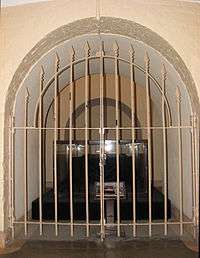Washington's Tomb (United States Capitol)
Washington's Tomb is an empty burial chamber two stories directly below the Rotunda of the United States Capitol building. It was included in the original design of the building by William Thornton and intended to entomb the body of George Washington, the first President of the United States. The original design of the rotunda, and the Crypt beneath it, included a central glass floor allowing the public to view Washington's Tomb two floors below, but this was never implemented. [1]

When Washington died in 1799, the Capitol was still under construction. Both houses of Congress passed a resolution calling for Washington to be entombed in the Capitol upon its completion. Martha Washington agreed to the plan despite the presence in her husband's will of a provision that he be buried at Mount Vernon. However, the original resolution was never carried out due to disputes over the specific design and cost of the tomb and the body was placed in a temporary tomb at Mount Vernon. Congress again attempted to resolve these issues in 1800, 1816, 1824, and 1829, when the Architect of the Capitol prepared plans for the tomb in anticipation of the approaching centennial of Washington's birth.[2]
Congress renewed its call to transfer the body to the Capitol in 1830, after an attempt to steal Washington's head in which the Mount Vernon tomb was vandalized and several of Washington's relatives' corpses desecrated in 1830, but the current owner of the property, John Washington, decided to build a new, more secure tomb on the site instead.[3]
Formerly, the Lincoln Catafalque was stored and exhibited in the tomb. It is kept, at present, in a specially constructed display area in the Exhibition Hall of the Capitol Visitor Center.[4]
See also
- Anıtkabir, Mausoleum of Mustafa Kemal Atatürk (Turkey)
- Mazar-e-Quaid (Pakistan)
- Che Guevara Mausoleum (Cuba)
- Santa Ifigenia Cemetery (Cuba)
- Kwame Nkrumah Mausoleum (Ghana)
- Sun Yat-sen Mausoleum (China)
- Cihu Mausoleum, Chiang Kai-shek (Republic of China, Taiwan)
- Touliao Mausoleum, Chiang Ching-kuo (Republic of China, Taiwan)
- Ho Chi Minh Mausoleum (Vietnam)
- House of Flowers (mausoleum), Josip Broz Tito (Serbia)
- Lenin's Mausoleum (Russia)
- Les Invalides, Sarcophagus of Napoleon Bonaparte (France)
- Mausoleum of Mao Zedong (China)
- Georgi Dimitrov Mausoleum (Bulgaria)
- Kumsusan Palace of the Sun (North Korea)
- National Chiang Kai-shek Memorial Hall (Republic of China, Taiwan)
- Türkmenbaşy Ruhy Mosque (Turkmenistan)
- Bourguiba mausoleum in Monastir (Tunisia)
- Unknown Soldier Memorial (Egypt) (Egypt)
- Reza Shah's mausoleum (Iran)
- Marcos Museum and Mausoleum (Philippines)
- Astana Giribangun (Indonesia)
- Valle de los Caídos (Spain)
References
- "How the Crypt Got its Name". AOC Curator Office. March 4, 2013. Retrieved June 7, 2016.
- "The Resolution to Bury President George Washington at the U.S. Capitol | US House of Representatives: History, Art & Archives". history.house.gov. Retrieved 2019-04-20.
- Carlsson, Brady (2016). Dead Presidents: An American Adventure into the Strange Deaths and Surprising Afterlives of Our Nations Leaders. Norton.
- "The catafalque". Architect of the Capitol. Retrieved June 7, 2016.